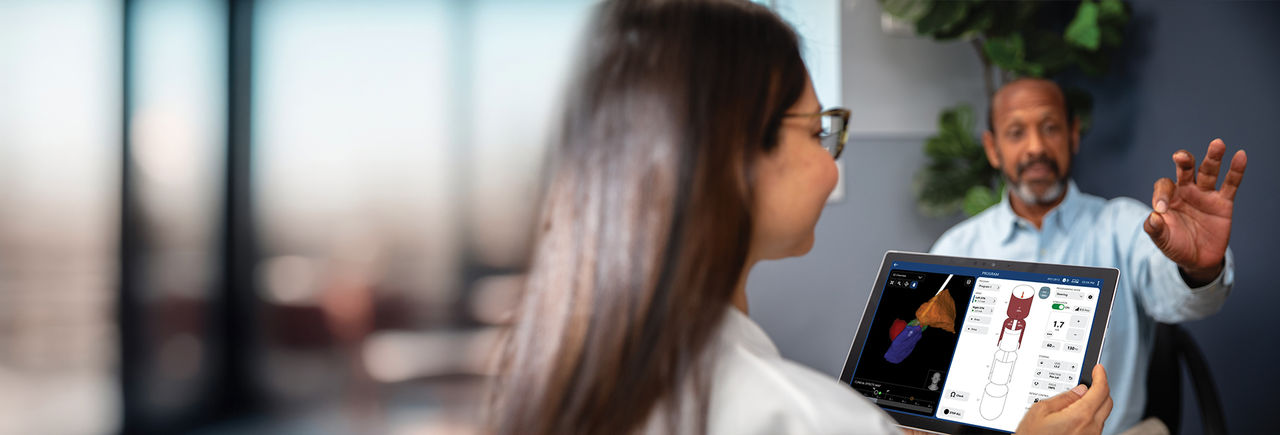Deep Brain Stimulation (DBS) is a revolutionary therapy designed to alleviate motor symptoms caused by neurological disorders such as Parkinson’s disease, dystonia, and essential tremor. This minimally invasive procedure involves a surgically implanted device that sends electrical impulses to specific areas of the brain, helping to regulate abnormal signals and improve quality of life.
How can DBS help me?


Stimulator

Lead
DBS uses a small, surgically implanted device called a “stimulator” to send signals to a targeted portion of your brain. This stimulation can improve your motor function by reducing symptoms such as tremor, slowness, and rigidity. Most centres perform this procedure asleep.
The stimulation may also result in fewer medicines to take each day or reduced dosages of your medications.
Because your medicine may be reduced, you could also have a reduction in some of the medication-related side effects such as motor fluctuations (ON-OFF condition) and involuntary movements, also referred to as dyskinesia. For people living with Dystonia, Essential Tremor or Parkinson’s, DBS therapy can be life-altering.
How does Deep Brain Stimulation work?
When people living with movement disorders experience a disturbance in motor symptoms, it’s because low dopamine levels in the brain are causing abnormal signaling. Deep Brain Stimulation (DBS) can help regulate those signals by targeting electrical stimulation. As a result, movement disorders symptoms are often reduced.
See how DBS works to control movement disorders symptoms.
Deep Brain Stimulation surgery
Is the procedure safe?
While there’s risk with every surgery, DBS isn’t a new therapy, and for many people living with Parkinson’s, Dystonia and Essential Tremor, DBS therapy is a normal part of their treatment journey. More than a quarter century of clinical trials and patient experiences have tested the safety and effectiveness of treating Parkinson’s, Dystonia and Essential Tremor with DBS. Hundreds of thousands of patients like you are already experiencing the benefits.
Dr. Jens Volkmann, MD Phd, Chairman and Professor of Neurology at University of Wurzburg (Germany) and global thought leader in DBS discusses the safety of Deep Brain Stimulaton.
Benefits of DBS therapy
Not all movement disorder’s patients are affected by the disease in the same way. The severity, type, and recurrence of any symptom will vary by individual. As will his or her response to DBS treatment. But quite often, DBS allows movement disorder’s patients to reduce the amount of medicine they take and live free from disruptive side effects such as uncontrolled movements, incontinence, and moodiness.
Benefits of DBS may include:


This material is for informational Purposes only and not meant for medical diagnosis. This information does not constitute medical or legal advice, and Boston Scientific makes no representation regarding the medical benefits included in this information. Boston Scientific strongly recommends that you consult with your physician on all matters pertaining to your health.
CAUTION: The law restricts these devices to sale by or on the order of a physician. Indications, contraindications, warnings, and instructions for use can be found in the product labelling supplied with each device or at www.IFU-BSCI.com. Products shown for INFORMATION purposes only and may not be approved or for sale in certain countries. This material not intended for use in France.
References:
1. Okun et al. Subthalamic deep brain stimulation with a constant-current device in Parkinson's disease: An open-label randomised, controlled trial. Lancet Neurology. 2012. 11(2): 140-149.
2. Timmerman et al. Multiple-source current steering in subthalamic nucleus deep brain stimulation for Parkinson's disease (the VANTAGE study): a non-randomized. prospective, multicentre, open-label study. Lancet Neurology. 2015. 14: 693-701.
3. Farris, S. and Giroux, M. (2013). DBS: A Patient Guide to Deep Brain Stimulation. Movement and Neuroperformance Center Colorado.
4. Vitek JL, Jain R, Chen L, et al. Subthalamic nucleus deep brain stimulation with a multiple independent constant current-controlled device in Parkinson’s disease (INTREPID): a multicenter, double-blind, randomised, sham-controlled study. Lancet Neurology. 2020;19(6):491‐501. doi:10.1016/S1474-4422(20)30108-3.
5. Krack P, Batir A, Van Blercom, N. Five-year follow-up of bilateral stimulation of the subthalmic nucleus in advanced Parkinson’s disease. N Eng J Med. 2003:349(20):1925-1934. doi:10.1056/NEJMoa035275.
6. Weaver et al. Bilateral deep brain stimulation vs best medical therapy for patients with advanced Parkinsons Disease: A randomized controlled trial. JAMA. 2009. 301: 63-73.


